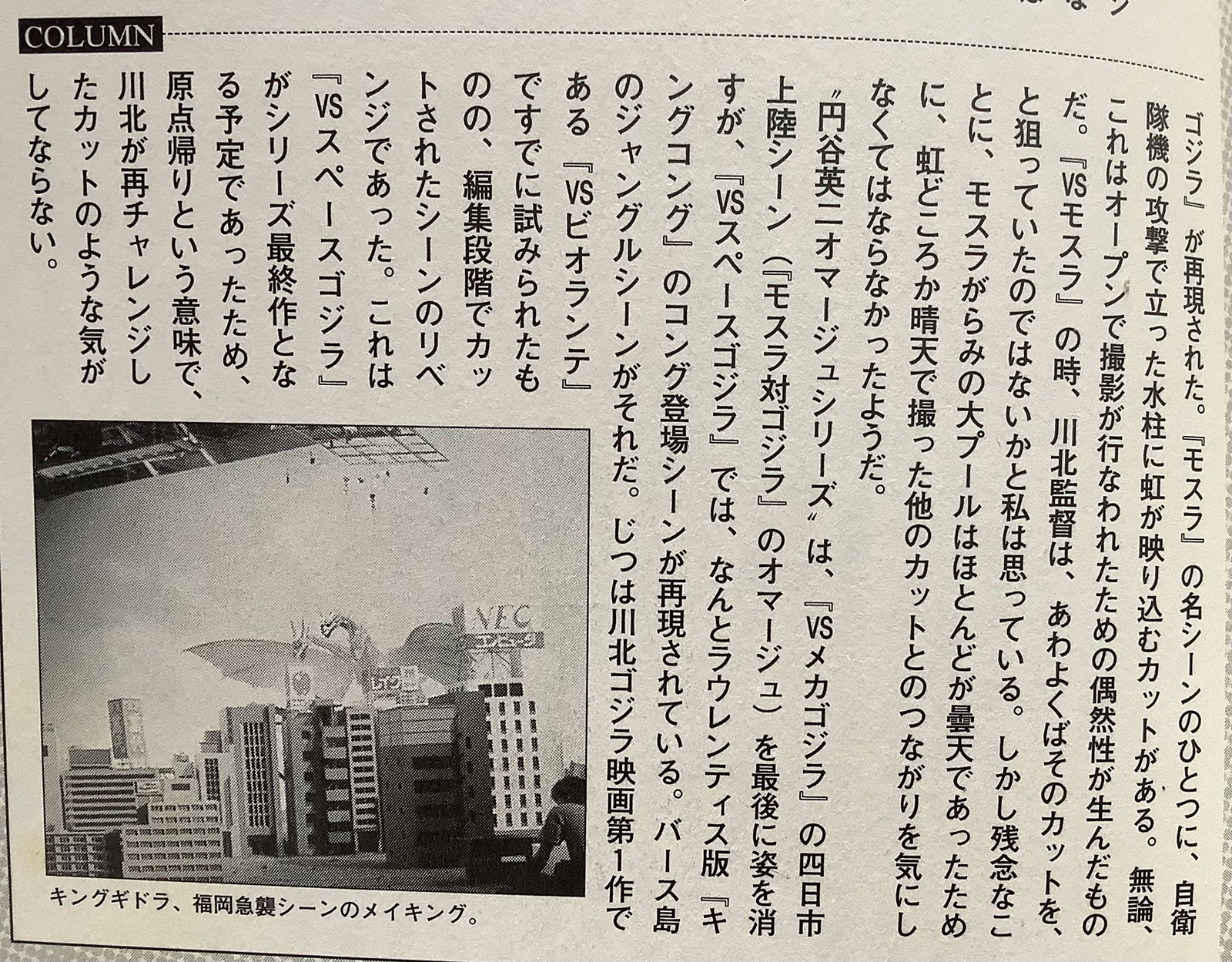3.22.2022
Kawakita Tribute to Tsuburaya


円谷英二へのオマージュ
A Tribute to Eiji Tsuburaya
川北紘一による名特撮シーンに彩られていた 〝平成ゴジラシリーズ〟。その中には「おや? どこかで見たような?」と、なにやらデジャヴを感じさせるシーンがいくつかある。例えば『ゴジラVSキングギドラ』におけるキングギドラの福岡急襲シーン、『ゴジラVSメカゴジラ』におけるゴジラの四日市上陸シーンなどだ。もったいぶるまでもなくそれらは、川北紘一が敬愛す 円谷英二特技監督が、かつて東宝特撮映画で描出していったイリュージョンへのオマージュあふれるシーンなのである。
The “Heisei Godzilla series” was colored by Koichi Kawakita’s famous special effects scene. Among them, there are some scenes that make you feel deja vu, such as “Oh? Like you saw it somewhere?” For example, the scene of King Ghidorah’s raid on Fukuoka in “Godzilla vs. King Ghidorah” and the scene of Godzilla’s landing in Yokkaichi in “Godzilla vs. Mechagodzilla”. Needless to say, these are scenes full of homage to the illusion that Koichi Kawakita’s beloved director Eiji Tsuburaya once portrayed in the Toho special effects movie.
その〝円谷英二オマージュシリーズ〟が最初に登場するのは、91年の『VSキングギドラ』である。福岡を襲った怪獣といえばラドンだが、57年の『空の大怪獣ラドン』のクライマックスは、福岡駅前での自衛隊とラドンの大交戦シーンであった。
The “Eiji Tsuburaya homage series” first appeared in “VS King Ghidorah” in 1991. Rodan is the monster that attacked Fukuoka, but the climax of “homage, the Great Sky Monster” in 1957 was the scene of a large battle between the Self-Defense Forces and Rodan in front of Fukuoka Station.
キングギドラが襲うのも福岡、川北は「ラドン』のあのシーンを自身の映画で再現しようと思い、駅に向かったそうである。しかし「ラドン』公開から34年という時の流れは、福岡駅前の 状況を一変させ、川北が狙った〝円谷英二のアングル〟を再現 させる場所にはカメラが入れなかったようだ。したがって川北 の当初の狙いは100%再現できたわけではないのだが、それでも 福岡のミニチュアは大きめのサイズ(大沢哲三によれば1/15)の ものが用意され、円谷英二時代に近い雰囲気の画面効果を醸し出していた。
King Ghidorah attacks Fukuoka, and Kawakita decided to recreate that scene of “Rodan” in his own movie, so he headed to the station. However, 34 years after the release of “Rodan,” the flow in front of Fukuoka station It seems that the camera could not be put in the place where Kawakita changed the situation and reproduced the “Eiji Tsuburaya’s angle” that Kawakita aimed at. Therefore, although Kawakita’s original aim was not 100% reproduced, it is still a miniature of Fukuoka. A larger size (1/15 according to Tetsuzo Osawa) was prepared, creating a screen effect with an atmosphere similar to that of Eiji Tsuburaya.
次ぐ『ゴジラ対モスラ』では、大プールでの火炎弾攻撃とバトラの名古屋出現シーンで、それぞれ『モスラ」と『モスラ対ゴジラ』が再現された。『モスラ』の名シーンのひとつに、自衛 隊機の攻撃で立った水柱に虹が映り込むカットがある。無論、これはオープンで撮影が行なわれたための偶然性が生んだもの だ。『VSモスラ」の時、川北監督は、あわよくばそのカットを、と狙っていたのではないかと私は思っている。しかし残念なこ とに、モスラがらみの大プールはほとんどが曇天であったため に、虹どころか晴天で撮った他のカットとのつながりを気にしなくてはならなかったようだ。
In the next “Godzilla vs. Godzilla”, “Mothra” and “Mothra vs. Godzilla” were reproduced in the flame bullet attack in the large pool and the scene of Battra’s appearance in Nagoya, respectively. One of the famous scenes of “Mothra” is a cut in which a rainbow is reflected on the water column that stood up due to the attack of the Self-Defense Forces aircraft. Of course, this was a coincidence because the filming was open. At the time of “VS Mothra”, I think that Kawakita was aiming for that cut, if it was a good idea. But unfortunately he had to worry about the connection with other cuts taken in fine weather, not just the rainbow, because the large pool around Mothra was mostly cloudy.
〝円谷英二オマージュシリーズ〟は、『VSメカゴジラ』の四日市 上陸シーン(『モスラ対ゴジラ」のオマージュ)を最後に姿を消 すが、 「VSスペースゴジラ』では、なんとラウレンティス版『キ ングコング』のコング登場シーンが再現されている。バース島 のジャングルシーンがそれだ。じつは川北ゴジラ映画第1作で ある『VSビオランテ』 ですでに試みられたも のの、編集段階でカットされたシーンのリベ ンジであった。これは『VSスペースゴジラ』 がシリーズ最終作となる予定であったため、原点帰りという意味で、川北が再チャレンジしたカットのような気がしてならない。
The “Eiji Tsuburaya homage series” disappears at the end of the Yokkaichi landing scene of “VS Mechagodzilla” (a homage to “Mothra vs. Godzilla”), but in “VS Space Godzilla”, the Laurentiis version of “King Kong” Kong The appearance scene is reproduced. That is the jungle scene of Birth Island. In fact, in the first Godzilla movie of Kawakita, he was already tried in a certain “VS Biollante,” but it was a revenge scene that was cut at the editing stage. This was because “VS Space Godzilla” was scheduled to be the final work of the series, so I don’t feel like Kawakita’s re-challenge cut in the sense of returning to the origin.
キングギドラ、 福岡急襲シーンのメイキング。
King Ghidorah, making the Fukuoka raid scene.
Source: 平成ゴジラ大全 1984-1995 (双葉社, p 153)